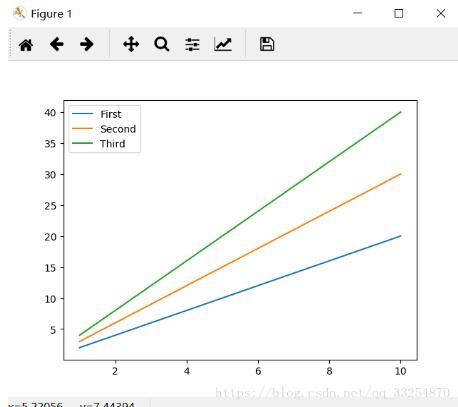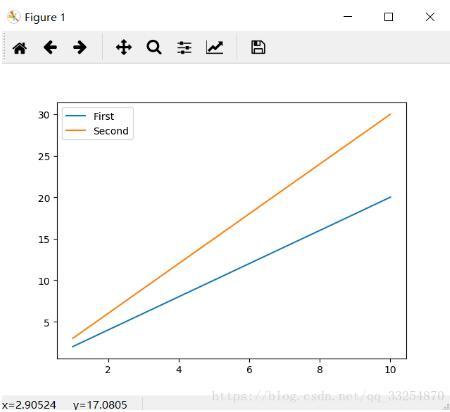1. 多曲线
1.1 使用pyplot方式
import numpy as np import matplotlib.pyplot as plt x = np.arange(1, 11, 1) plt.plot(x, x * 2, label="First") plt.plot(x, x * 3, label="Second") plt.plot(x, x * 4, label="Third") plt.legend(loc=0, ncol=1) # 参数:loc设置显示的位置,0是自适应;ncol设置显示的列数 plt.show()1.2 使用面向对象方式
import numpy as np import matplotlib.pyplot as plt x = np.arange(1, 11, 1) fig = plt.figure() ax = fig.add_subplot(111) ax.plot(x, x * 2, label="First") ax.plot(x, x * 3, label="Second") ax.legend(loc=0) # ax.plot(x, x * 2) # ax.legend([”Demo“], loc=0) plt.show()
2. 双y轴曲线
双y轴曲线图例合并是一个棘手的操作,现以MNIST案例中loss/accuracy绘制曲线。
import tensorflow as tf from tensorflow.examples.tutorials.mnist import input_data import time import matplotlib.pyplot as plt import numpy as np x_data = tf.placeholder(tf.float32, [None, 784]) y_data = tf.placeholder(tf.float32, [None, 10]) x_image = tf.reshape(x_data, [-1, 28, 28, 1]) # convolve layer 1 filter1 = tf.Variable(tf.truncated_normal([5, 5, 1, 6])) bias1 = tf.Variable(tf.truncated_normal([6])) conv1 = tf.nn.conv2d(x_image, filter1, strides=[1, 1, 1, 1], padding='SAME') h_conv1 = tf.nn.sigmoid(conv1 + bias1) maxPool2 = tf.nn.max_pool(h_conv1, ksize=[1, 2, 2, 1], strides=[1, 2, 2, 1], padding='SAME') # convolve layer 2 filter2 = tf.Variable(tf.truncated_normal([5, 5, 6, 16])) bias2 = tf.Variable(tf.truncated_normal([16])) conv2 = tf.nn.conv2d(maxPool2, filter2, strides=[1, 1, 1, 1], padding='SAME') h_conv2 = tf.nn.sigmoid(conv2 + bias2) maxPool3 = tf.nn.max_pool(h_conv2, ksize=[1, 2, 2, 1], strides=[1, 2, 2, 1], padding='SAME') # convolve layer 3 filter3 = tf.Variable(tf.truncated_normal([5, 5, 16, 120])) bias3 = tf.Variable(tf.truncated_normal([120])) conv3 = tf.nn.conv2d(maxPool3, filter3, strides=[1, 1, 1, 1], padding='SAME') h_conv3 = tf.nn.sigmoid(conv3 + bias3) # full connection layer 1 W_fc1 = tf.Variable(tf.truncated_normal([7 * 7 * 120, 80])) b_fc1 = tf.Variable(tf.truncated_normal([80])) h_pool2_flat = tf.reshape(h_conv3, [-1, 7 * 7 * 120]) h_fc1 = tf.nn.sigmoid(tf.matmul(h_pool2_flat, W_fc1) + b_fc1) # full connection layer 2 W_fc2 = tf.Variable(tf.truncated_normal([80, 10])) b_fc2 = tf.Variable(tf.truncated_normal([10])) y_model = tf.nn.softmax(tf.matmul(h_fc1, W_fc2) + b_fc2) cross_entropy = - tf.reduce_sum(y_data * tf.log(y_model)) train_step = tf.train.GradientDescentOptimizer(1e-3).minimize(cross_entropy) sess = tf.InteractiveSession() correct_prediction = tf.equal(tf.argmax(y_data, 1), tf.argmax(y_model, 1)) accuracy = tf.reduce_mean(tf.cast(correct_prediction, "float")) sess.run(tf.global_variables_initializer()) mnist = input_data.read_data_sets("MNIST_data/", one_hot=True) fig_loss = np.zeros([1000]) fig_accuracy = np.zeros([1000]) start_time = time.time() for i in range(1000): batch_xs, batch_ys = mnist.train.next_batch(200) if i % 100 == 0: train_accuracy = sess.run(accuracy, feed_dict={x_data: batch_xs, y_data: batch_ys}) print("step %d, train accuracy %g" % (i, train_accuracy)) end_time = time.time() print("time:", (end_time - start_time)) start_time = end_time print("********************************") train_step.run(feed_dict={x_data: batch_xs, y_data: batch_ys}) fig_loss[i] = sess.run(cross_entropy, feed_dict={x_data: batch_xs, y_data: batch_ys}) fig_accuracy[i] = sess.run(accuracy, feed_dict={x_data: batch_xs, y_data: batch_ys}) print("test accuracy %g" % sess.run(accuracy, feed_dict={x_data: mnist.test.images, y_data: mnist.test.labels})) # 绘制曲线 fig, ax1 = plt.subplots() ax2 = ax1.twinx() lns1 = ax1.plot(np.arange(1000), fig_loss, label="Loss") # 按一定间隔显示实现方法 # ax2.plot(200 * np.arange(len(fig_accuracy)), fig_accuracy, 'r') lns2 = ax2.plot(np.arange(1000), fig_accuracy, 'r', label="Accuracy") ax1.set_xlabel('iteration') ax1.set_ylabel('training loss') ax2.set_ylabel('training accuracy') # 合并图例 lns = lns1 + lns2 labels = ["Loss", "Accuracy"] # labels = [l.get_label() for l in lns] plt.legend(lns, labels, loc=7) plt.show()注:数据集保存在MNIST_data文件夹下
其实就是三步:
1)分别定义loss/accuracy一维数组
fig_loss = np.zeros([1000]) fig_accuracy = np.zeros([1000]) # 按间隔定义方式:fig_accuracy = np.zeros(int(np.ceil(iteration / interval)))2)填充真实数据
fig_loss[i] = sess.run(cross_entropy, feed_dict={x_data: batch_xs, y_data: batch_ys}) fig_accuracy[i] = sess.run(accuracy, feed_dict={x_data: batch_xs, y_data: batch_ys})3)绘制曲线
fig, ax1 = plt.subplots() ax2 = ax1.twinx() lns1 = ax1.plot(np.arange(1000), fig_loss, label="Loss") # 按一定间隔显示实现方法 # ax2.plot(200 * np.arange(len(fig_accuracy)), fig_accuracy, 'r') lns2 = ax2.plot(np.arange(1000), fig_accuracy, 'r', label="Accuracy") ax1.set_xlabel('iteration') ax1.set_ylabel('training loss') ax2.set_ylabel('training accuracy') # 合并图例 lns = lns1 + lns2 labels = ["Loss", "Accuracy"] # labels = [l.get_label() for l in lns] plt.legend(lns, labels, loc=7)
以上这篇TensorFlow绘制loss/accuracy曲线的实例就是小编分享给大家的全部内容了,希望能给大家一个参考,也希望大家多多支持python博客。
-
<< 上一篇 下一篇 >>
标签:numpy matplotlib
TensorFlow绘制loss/accuracy曲线的实例
看: 1246次 时间:2020-10-26 分类 : python教程
- 相关文章
- 2021-12-20Python 实现图片色彩转换案例
- 2021-12-20python初学定义函数
- 2021-12-20图文详解Python如何导入自己编写的py文件
- 2021-12-20python二分法查找实例代码
- 2021-12-20Pyinstaller打包工具的使用以及避坑
- 2021-12-20Facebook开源一站式服务python时序利器Kats详解
- 2021-12-20pyCaret效率倍增开源低代码的python机器学习工具
- 2021-12-20python机器学习使数据更鲜活的可视化工具Pandas_Alive
- 2021-12-20python读写文件with open的介绍
- 2021-12-20Python生成任意波形并存为txt的实现
-
搜索
-
-
推荐资源
-
Powered By python教程网 鲁ICP备18013710号
python博客 - 小白学python最友好的网站!